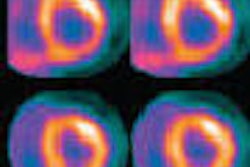The combination of healthcare information technology (HIT) and molecular medicine, with its capability for early disease detection through functional imaging modalities such as SPECT and PET as well as genomic and proteomic screening, could change the paradigm of healthcare delivery, according to a presentation at the 2007 Healthcare Information and Management Systems Society (HIMSS) conference in New Orleans earlier this year.
"The molecular medicine revolution, to the extent that it is one, is taking a starvation of data (for the clinical decision-making process) and turning it into an avalanche of data," said Keith Strier. "That's not necessarily a good thing for clinicians because they already have little time to do the things they need to do to practice effective and safe medicine -- the information flow is quite a torrent."
Strier, an attorney in the Life Sciences and Health Care practice of Deloitte Consulting in Chicago, and Dr. Lyle Berkowitz, medical director of clinical information systems of Chicago's Northwestern Memorial Physicians Group, shared their insight into the possibilities of IT-driven molecular medicine.
"IT-enabled molecular medicine is mostly about the new science and the discipline of managing this load of information," Strier said. "At an even higher level, clinically speaking, it's about playing a role in the translation of discoveries in the lab and bringing them into the clinic."
Diagnostic imaging professional societies are playing their part in this effort. In June 2006, the Reston, VA-based SNM initiated a $5 million "Bench to Bedside" campaign to allow significant molecular imaging discoveries made by scientists at lab benches to be translated into practice and used by physicians.
The American College of Radiology (ACR), the American College of Radiology Imaging Network (ACRIN), and the Academy of Molecular Imaging (AMI) successfully launched the National Oncologic PET Registry (NOPR) in May 2006. The registry permits participating Medicare beneficiaries to receive reimbursement for PET scans of many types of cancers, including brain, cervical, small cell lung, pancreatic, testicular, and ovarian, in return for their referring physician's participation in providing study data to NOPR.
The NUGene Project collects and stores genetic samples along with associated healthcare information from more than 6,100 patients of Northwestern-affiliated hospitals and clinics, and makes its DNA collection available to scientists conducting genetic research. According to Berkowitz, the project seeks to increase the understanding of genetic mechanisms underlying common diseases, assist in the development of DNA-based technology for diagnosis and treatment of disease, and aid physicians and other healthcare providers in the application of genetics to the practice of medicine.
The Clinical Proteomic Technologies Initiative for Cancer has a $104 million budget invested in a five-year effort to develop technologies, data, reagents and reference materials, analysis systems, and infrastructure needed to advance protein biology for the diagnosis, treatment, and prevention of cancer. This joint venture between the National Cancer Institute (NCI) and the U.S. Food and Drug Administration (FDA) is seeking to correlate protein and gene expression patterns for the early detection and screening of cancer, as well as establish therapeutic response end points and monitor drug toxicity during treatment, Berkowitz said.
What these efforts, as well as other studies under way worldwide, mean for chief technology officers and system administrators is that molecular medicine unquestionably will be playing a larger role in the continuum of care as more of these developments come on line over the next five to 10 years. According to Strier, the fundamental provisions of healthcare -- prevention, diagnosis, and treatment -- will continue to be supplied by clinicians; however, the integration of molecular medicine will refine those elements to provide better care and will present new HIT challenges.
Decision-support tools for clinicians will routinely include new biomarkers for baseline risk from stable genomics such as single nucleotide, polymorphisms, halotype mapping, and gene sequencing. Dynamic genomics such as gene expression, proteomics, metabolomics, and molecular imaging will also be an evolving part of the preclinical progression. In the near term, these will manifest as pharmacogenomic, diagnosis, and treatment alerts in a computerized physician order entry system (CPOE) comprising part of an electronic healthcare record (EHR) system, according to Berkowitz.
Storage will also be impacted, both in physical terms as patient datasets increase, and virtually as disparate clinical systems store, retrieve, and interface images and data with one another. As yet there is no common nomenclature for genomics and proteomics in HIT systems, Berkowitz said. Therefore, there is no standard methodology for delivering BRCA1 and BRCA2 test results to a radiologist prior to a patient undergoing a mammogram or ovarian ultrasound.
"The implications and impact for IT in the future is being able to integrate the genomics, proteomics, and molecular imaging data as part of the electronic medical record," Berkowitz said.
By Jonathan S. Batchelor
AuntMinnie.com staff writer
April 6, 2007
Related Reading
Molecular markers: Putting too fine a point on DCIS? March 15, 2007
PACS developer offers image-enable EHR guidance, March 1, 2007
Regulatory carve-outs hope to spur HIT growth in U.S., February 28, 2007
New growth for diagnostic radiopharmaceuticals, November 9, 2006
Integrating IT and QI for higher-quality patient care, November 2, 2006
Copyright © 2007 AuntMinnie.com




















